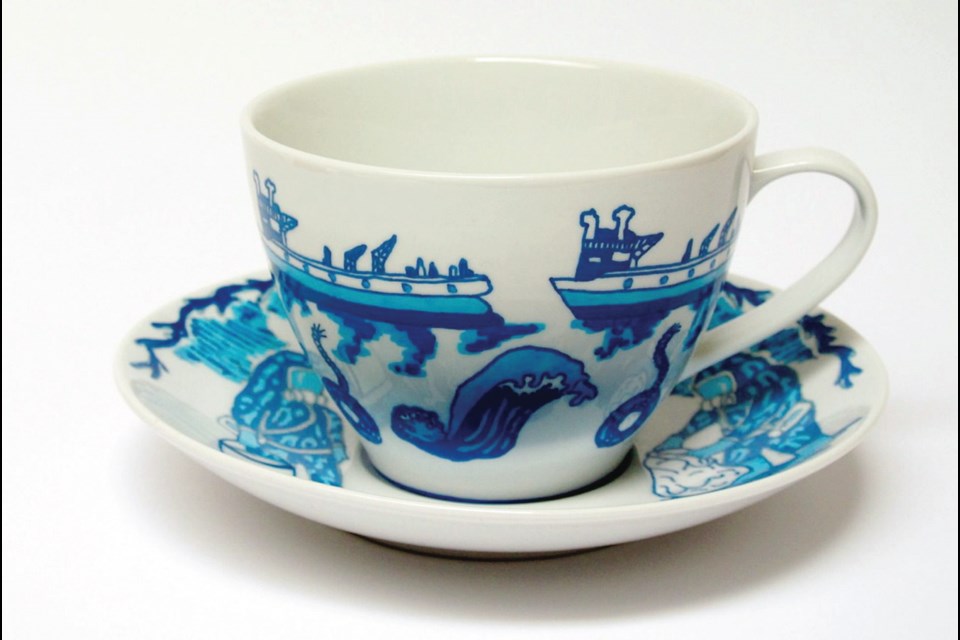 Chris Savage is an artist from Victoria, a slender and well-spoken young man. You’d never guess to look at him that he had played hockey for the Victoria Cougars in the past.
Chris Savage is an artist from Victoria, a slender and well-spoken young man. You’d never guess to look at him that he had played hockey for the Victoria Cougars in the past.
After some years of education at Camosun College, with the valued encouragement of his teacher John Boehme Jr., Savage moved to the University of Victoria and graduated in fine art. It was there, in his last semester, that he decided to explore the concept of blue and white pottery, and his current exhibit is an evolution of that idea.
Savage chose it because blue and white is one of the great international cultural expressions, a useful and decorative product, which has been altered by every nation that took it up. In the beginning, it was the people of Persia in the 12th century who loved the pottery decorated with cobalt blue underglaze. But their pottery was low-fired, and the Chinese, who were expert potters, stepped in to create wares for the export market using blue designs on a fine white porcelain body. These pots were shipped all over the east.
When they set up trading stations in Asia, the Dutch traders began sending shipments of blue and white wares home to Holland, which at that point wasn’t able to make porcelain. So they began making stoneware with an opaque white glaze of tin, and painted their designs on top with blue, creating a less expensive domestic imitation of porcelain, or to replace pieces broken at sea. This was called Delftware. Inevitably, they metamorphosed the original Persian or Chinese designs into scenes of the Italian campana or Dutch windmills.
The potters, who were mostly Huguenots, were driven out of Holland by religious forces, and took their pottery skills to England. There, English Delftware intersected with the British development of “bone china,” a pseudo-porcelain.
With the rise of the Industrial Age, and the invention of “transfer printing” rather than hand-painting the plates, now decorated pottery was suddenly available to most of the population. The names Spode and Wedgwood carry this domestic ceramic style forward even today.
From there, pottery came to the American colonies, and later British and Americans went to Japan where, in the 20th century, they learned techniques to revive their own industries. Like the jet stream, blue and white décor has by now travelled all the way around the earth.
Savage decided to take up the motif and reinvigorate it with contemporary themes, knowing he was part of a long tradition. Like many of us, he had discovered blue and white at his grandparents’ home.
“My grandparents had that sort of stuff in a big old wooden cabinet behind glass,” he recalled. “The patterns showed old farm scenes. They were English, and that sort of stuck with me. I built off that, and I’ve been trying to bring it forward.”
Savage is not a potter. His approach has been to visit thrift shops and buy plain white pottery — much of it from Ikea — and then draw his designs on this by hand. He starts with a design drawn on paper with graphite and makes a sort of transfer paper, which he uses to transfer his design to the china ware. For the final finish, he draws with an oil-based ink pen.
Then, when the design is complete, he bakes it in a convection oven at about 400 degrees for 45 minutes.
“If used as a functional object, it will fade away to the plain white again,” he admits.
Clearly, it is not the technique but the imagery that is of interest to Savage. I asked about one of his plates, which at a distance looked like Spode but up close showed pictures of solar panels energizing a satellite.
“My themes are from current events and news stories, mostly disastrous ecological stuff,” he told me. The satellites refer to mining surveys done from above, mapping the underground. On earth, the plants struggle to come back to life, birds are dropping out of the sky amid a shower of plus signs and minus signs. The earth below has been strip-mined. The artist says that “changing the landscape affects everything around it.”
All this bad news on tea pots and dessert plates?
“That makes an interesting juxtaposition: rather than a windmill or a nice landscape, this is relevant to how our relationship with the landscape is becoming less beneficial to the environment around it.” A cheerful little teapot has a cartoony airplane painted on it.
“It’s a drone,” Savage reminds me. Above are a couple of missiles, and below is a filigree of barbed wire, with wilting olive branches all around.
Savage is just back from a trip to Portugal where the ceramic tradition, including blue and white, is alive and well, as it has been from the time when the Arabs were at home on the Iberian peninsula. He has a “day job” working at a printing company at the moment, which he finds is a nice balance to his creative work.
The current show also includes some drawings on paper with watercolour pencils and a linen tea cloth with a faux-Oriental pattern, all in blue and white. It’s too soon to tell where his creative instincts will take lead, but Chris Savage in his own way has joined a larger movement.
Breaking Point, a show by Christopher Savage of Victoria, is on until Sept. 20 at XGallery (2333 Government St., 250-382-0442, xchangesgallery.org, open Saturday and Sunday, 12 to 4 pm). For more detail, visit christophersavage.ca.



